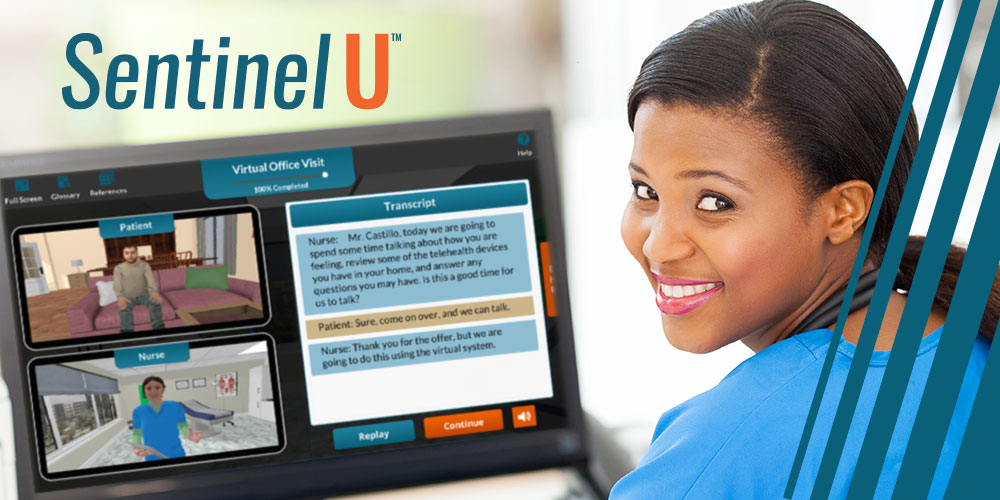Sentinel U Launches Interprofessional Teams Virtual Simulation Series for Nursing
Long before the world was grappling with the coronavirus pandemic, nursing schools across the country were embracing virtual nursing through clinical simulation experiences. Sentinel U, a division of American Sentinel University formerly known as Healthcare Learning Innovations, offers such simulated learning opportunities with a focus on nursing and healthcare professionals. Serving as a pioneer in online simulation education, Sentinel U delivers high-quality medical simulation training and learning experiences through virtual simulation environments to tens of thousands of learners worldwide. Interprofessional Teams is the NEWEST healthcare simulation tool from Sentinel U and works to further expand the learning possibilities.
“We’re really excited about this new addition to the Sentinel U product suite of offerings,” President of Sentinel U Jeffrey Caplan said. “Leadership and communication skills are vital for nurses, who are often on the front lines of caring for patients. They stand alongside doctors and other advanced-practice healthcare professionals, and as they move into leadership type roles, they are tasked with important things like bridging the gap between policy implementation and patient care. This series of virtual clinical simulations will help nurses and nursing students everywhere build and practice these essentials.”
Interprofessional Teams is a virtual clinical simulation ideal for learners and practicing nurses. The solution invites the user to act as a nurse to get to know “Jenny,” a 9 year-old, and her mother. “Jenny” is modeled after a typical adolescent with a range of challenges, including school difficulties, vision problems and other health-related needs.
Sponsored Content:
Through a series of modules the nursing learner addresses a variety of Jenny’s physical and psychosocial needs. The learner selects an interprofessional team of five members and continues to provide care for Jenny. As the simulation follows her through her life into young adulthood and beyond, the learner must find ways to properly get the information needed to make decisions in Jenny’s best interests.
“Like a real patient, Jenny isn’t always forthcoming about her needs,” Christi Doherty, director of academic simulations for Sentinel U and assistant professor of nursing at American Sentinel University, said. “We’ve designed the program to get learners thinking about how to frame questions correctly, how to communicate in ways that invite Jenny to open up, not shut down. Learners need to understand group dynamics, too and how to go into a room without putting off others.”
The Interprofessional Teams healthcare simulation solution’s main objective is to help learners recognize challenges and barriers involved when working with a diverse team of professionals. Another benefit for nursing programs and hospitals employing Sentinel U platform is that the platform can help faculty avoid disrupting nursing students’ learning during a time when nurses are in demand.
Virtual simulation solutions can be used from anywhere and at any time to meet the demands of all learners and their educators. Doherty, who helped personally create the content for Interprofessional Teams, explained how the program is designed to help new and practicing nurses build their critical thinking skills.
Sponsored Content:
More About Sentinel U’s Interprofessional Teams Healthcare Simulation Solution
With this solution the learner is able to make decisions, asks questions, and guides conversations with peers. The use of virtual peers increases patient safety in real life by allowing learners to experiment with making decisions that are best for Jenny’s health and well-being without risk of error. Interprofessional Teams allows the learner to interact with 14 other healthcare professionals as virtual characters and choose the best five-person team to care for Jenny. Members of that team might include a physician, school nurse, optometrist, pharmacist, therapist and a registered dietician.
“It’s critical that nurses are comfortable communicating with other members of a healthcare team,” Doherty said. “We created this simulation in direct response to a survey of hospitals, who told us that nurses today need these soft skills. It isn’t always comfortable for them to speak up and talk with physicians in the room or offer suggestions on what patients need, but it’s vital. With Interprofessional Teams, we are giving nurses a safe environment in which they can practice doing so.”
Doherty additionally explained that nurses get exposure in the real world to different healthcare professionals, but don’t always recognize the best ways to collaborate with them. Programs that transition Registered Nurses and Advanced Practice Registered Nurses into new practice settings, and also want to achieve accreditation from the American Nurses Credentialing Center Practice Transition Accreditation Program® (PTAP), will find Interprofessional Teams a valuable tool.
Interprofessional Teams can expand upon this by allowing learners to a great program for those wanting to earn an ANCC Practice Transition Accreditation Program. When applying for this accreditation, ANCC asks that organizations prove many standards, but one is how interprofessional teamwork is incorporated throughout their curriculum. Candidates seeking this accreditation are asked to “Describe and demonstrate how the development and application of working as a member of an interprofessional team is integrated into the program.”
Interprofessional Teams maps to the American Association of Colleges of Nursing (AACN) Professional Competencies for BSN, MSN and DNP programs, and Quality and Safety Education for Nurses (QSEN) Competencies. The solution also aligns with the National Council Licensure Examination (NCLEX) categories of Safe and Effective Care Environment, Management of Care, and Psychosocial Integrity.
That means that a nursing school can integrate the virtual clinical series into the school’s current curricula and a hospital system can easily adopt Interprofessional Teams as a stand-alone training program. The goal is always the same: to help learners develop and improve their abilities to work with multiple healthcare professionals from many different backgrounds, and resolve conflicts in order to achieve quality patient care.
“[Our] healthcare simulations are especially helpful because you can’t curate a real clinical environment to expose a nurse to a doctor and a therapist and a dietitian,” she said. “Our simulations allow learners to experience that in a way they might not actually get the chance to do until much later in their real careers,” Doherty said.
Today, more than 200 schools and healthcare organizations across the United States and Canada use Sentinel U to provide their learners with the freedom to take risks and learn. The identification of needs based on individual clinical sites is a task that was a challenge even before the COVID-19 pandemic forced schools everywhere online. Therefore, one benefit of the company’s online platform is that these solutions are more convenient than trying to identify appropriate clinical sites in person.
Learn More About Sentinel U Today!
Lance Baily, BA, EMT-B, is the Founder & CEO of HealthySimulation.com, which he started while serving as the Director of the Nevada System of Higher Education’s Clinical Simulation Center of Las Vegas back in 2010. Lance is also the Founder and acting Advisor to the Board of SimGHOSTS.org, the world’s only non-profit organization dedicated to supporting professionals operating healthcare simulation technologies. His co-edited Book: “Comprehensive Healthcare Simulation: Operations, Technology, and Innovative Practice” is cited as a key source for professional certification in the industry. Lance’s background also includes serving as a Simulation Technology Specialist for the LA Community College District, EMS fire fighting, Hollywood movie production, rescue diving, and global travel. He and his wife Abigail Baily, PhD live in Las Vegas, Nevada with their two amazing daughters.
Sponsored Content:


















